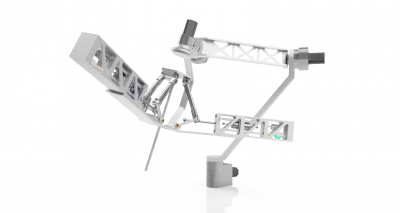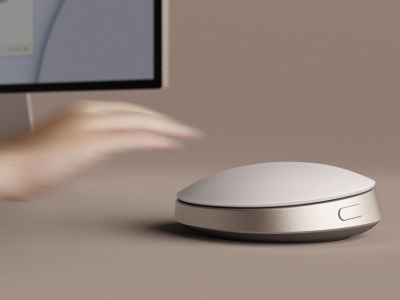By Alysha A. Cunningham
Roughly 15,000 people in Canada undergo coronary artery bypass grafting (CABG) surgery each year, improving heart function due to disease, heart attack or other complications. Recovery from this highly invasive procedure can take up to 12 weeks.
As the Canadian population continues to age, this cardiac surgery is being offered more increasingly and to older, sicker and more frail patients—creating higher rates of complications. What if there was a more efficient and less invasive way to perform this life saving procedure?

CAD image of the SQUiiDBot design.
In just 36-hours, a team of three engineering students from Carleton and Ryerson universities may have designed a solution of the future by participating in the inaugural Carleton University Design League (CUDL) Designathon—a fast-paced design competition where engineering students showcase their computer-aided design (CAD) skills while creating 3D solutions to real-world engineering problems.
This first of its kind, student-led initiative at Carleton was held in a discord server over the weekend of March 18 as part of National Engineering Month. Over 80 students worked in teams over 36-hours to create models that would solve a unique problem statement that touched on various fields of engineering. Graduate students, professors and representatives from the event sponsors, Carleton’s Faculty of Engineering and Design and Lockheed Martin judged the projects.
One of the most remarkable challenges undertaken during the three-day event was the Beating Heart Surgical Tool, formulated by Carleton Systems and Computer Engineering Prof. Carlos Rossa.
“This is a particularly challenging design project as the tool must follow the motion of a point on the heart surface to allow the surgeon to operate on a seemingly static surface,” explains Rossa. “At first, I thought that this project would be too complicated for a 36-hour design challenge, but I was pleasantly surprised to see what the students came up within such a short period of time.”
The winning project, SQUiiDBot, combined the efforts of students from three different engineering disciplines: Jake Birkness, aerospace engineering; Zuhayr Khan, mechanical engineering; and Alia Nichol, biomedical and mechanical engineering. Together, they designed a concept for a medical tool that helps surgeons perform CABG surgery with increased accuracy and efficiency.

Alia Nichol, Biomedical and Mechanical Engineering student
The most common approach to CABG requires breaking the ribs and sternum of the patient through a 12 to 14-inch incision in order to expose the patient’s heart and arteries, then stopping the heart in order to connect it to the bypass machine.
“Current CABG surgical tools can be difficult for surgeons to use and attach to the heart due to its continuous beating motion,” explains Nichol. “These tools can also apply restrictive forces to the heart which can significantly increase the risk for damage.”

Jake Birkness, Aerospace Engineering student
Their winning design proposes an alternative and a less-invasive solution. By using the designed SQUiiDBot surgical robotic arm, surgeons would be able to perform the procedure on the heart with increased ease and through a much smaller opening of only two to three inches between the ribs. This would not restrict the motion of the heart in any way, ultimately increasing the accuracy of the operation while minimizing pain and recovery time for the patient.
“If you had told me that I would spend nearly 36-hours straight researching heart surgery and creating a CAD model of a robotic arm, I would have called you crazy,” says Birkness.
The winning student trio say they’re grateful for the opportunity to think creatively and apply their skills outside of the classroom while under the mentorship of faculty and industry experts.
“It is great to see our students translating what they learned in class into real-world problems that can have a direct impact on societal challenges,” says Rossa. “The challenge brought together students from different engineering programs, with various backgrounds and expertise. What they accomplished in such a short period of time is astonishing and it is a strong testament to the passion they have for engineering. I’m very proud of them.”
“This Designathon was an incredible opportunity to apply our CAD skills and tackle a real-world problem,” says Nichol. “I’m especially grateful for my teammates diverse skill sets and constant determination even while sleep deprived. Thanks for sponsoring this event and empowering young designers.”
The CUDL comprises of a group of students dedicated to providing the Carleton community with opportunities to develop, apply, and showcase their design skills in a meaningful way outside of the classroom. In addition to the Designathon, the club hosts CAD workshops throughout the year.
Tuesday, March 29, 2022 in Engineering, Faculty of Engineering and Design, Technology
Share: Twitter, Facebook



